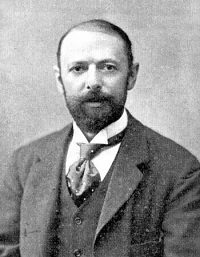

| Frederic Eugene Ives |

|
(b. Feb. 17, 1856, Litchfield, Conn., U.S.--d. May 27, 1937, Philadelphia), American photographer and inventor. As a boy, Ives was apprenticed to a printer at the Litchfield Enquirer, where he became interested in photography. By the time he was 18 years old, he was in charge of the Cornell University photographic laboratory. While there, he developed an early halftone process using a gelatin relief. He continued to improve this process, and in 1881 he worked on the first commercial production of halftone printing plates using his method; in 1885 he introduced an improved halftone screen. Among Ives's 70 patents were those for halftone photogravure (anticipating rotogravure); the modern short-tube, single-objective binocular microscope; and the photochromoscope (also called kromskop) camera and the chromogram (also spelled kromogram). The latter, a viewing instrument that accurately combined and projected the three-separation colour negative produced by the former, was of particular importance in the development of full-colour projection. Some of his early prints are preserved in the Smithsonian Institution, Washington, D.C. Photography's transmutation of nature's colours into various shades of black and white had been considered a drawback of the process from its inception. Hence, at the request of a client, many portrait photographers collaborated with artists who hand-tinted daguerreotypes and calotypes or painted over albumen prints in oils. Some artists also copied the photograph onto canvas; others, such as Franz von Lenbach in Munich, had the image projected onto canvas that had been made light-sensitive, whereupon they painted freely over it. In Japan, where hand-coloured woodcuts had a great tradition and labour was cheap, some firms from the 1870s on sold photographs of scenic views and daily life that had been delicately hand-tinted. In the 1880s photochromes, colour prints made from hand-coloured photographs, became fashionable and remained popular until they were gradually replaced in the first decades of the 20th century by Autochrome plates. The Autochrome process, the first practical colour photography process, was introduced in France in 1907 by Auguste and Louis Lumière. It used a colour screen (a glass plate covered with grains of starch dyed to act as primary-colour filters and black dust that blocked all unfiltered light) coated with a thin film of panchromatic (i.e., sensitive to all colours) emulsion and resulted in a positive colour transparency. The Lumières' success was due in part to the introduction of panchromatic emulsion the previous year by a London firm of photographic plate manufacturers. All previous experimenters trying to solve the problem of colour photography had been seriously impeded by the comparative insensitivity of the earlier negative material to all colours except blue and violet. |
 |
|

| Back to the Stereoscopy.com FAQ Page |
